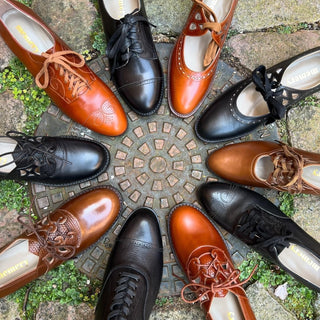Discover the Timeless Appeal of Oxford Shoes
Explore the enduring charm of Oxford shoes, from their origins as practical men's footwear in the 1800s to their evolution into a versatile staple in women’s wardrobes. Learn about classic styles like the Oxford and Derby shoes, as well as unique variations such as spectator shoes. With deep historical roots and a perfect blend of style and functionality, these shoes remain an iconic choice in fashion.
Oxfords for Men
The Origin of Oxford Shoes
Oxford shoes, also known as Balmoral shoes, originated in the early 1800s as practical footwear for men, commonly worn for daily use. The style became popular among students at Oxford University, which led to its name. While the exact date of their creation remains uncertain, Oxford shoes have been a staple for over two centuries.
Gaining Popularity Beyond Oxford
During the 19th century, Oxford shoes gradually gained popularity outside the university. Their refined design made them an ideal choice for formal occasions, aligning with the era’s emphasis on propriety and decorum. The Industrial Revolution of the late 1800s further contributed to their widespread adoption, as advancements in manufacturing made high-quality footwear more affordable and accessible to the growing middle class. As a result, Oxford shoes quickly became an essential part of men’s wardrobes.

Our William Oxford boot is a classic 1910s men’s style, featuring a closed lacing system, characteristic of the period.
Oxford Shoes in Hollywood
The 1930s and 1940s saw Hollywood further cement Oxford shoes' popularity, as leading men in classic films frequently wore them. This exposure helped transition the Oxford from a strictly formal shoe to a versatile everyday choice for men.
Oxfords for Women
By the late 19th century, elements of men’s fashion began integrating into women’s wardrobes, including shirts, ties, and waistcoats, due to their functionality and practicality. This shift was further accelerated during World War I, when many women entered male-dominated workplaces. The growing emphasis on sportswear in early 20th-century fashion also influenced footwear choices, leading to the adoption of Oxford shoes as a practical and versatile option for women.

Our Florence Oxford shoe reflects one of the earliest styles worn by women in the 1910s, featuring a low, practical heel.
Oxfords with Heels
By the 1920s, the Oxford evolved with the introduction of higher heels, including the fashionable curved French heel of the era. This shift transformed the Oxford from a purely utilitarian men’s shoe into a stylish statement piece for women. It became a practical yet elegant choice, appealing to both working women and high society. By the end of the decade, the Oxford had firmly established itself as a classic in women’s fashion.
Oxfords During WWII
In the 1930s and 1940s, Oxford shoes continued to thrive, often featuring a low block heel that balanced practicality with femininity. Typically made from brown or black leather, they offered versatility, pairing well with various outfits. This was particularly valuable during wartime, when leather shortages and rationing meant wardrobes were limited. Over time, decorative elements such as cut-outs, intricate stitching, and stamped leather patterns became popular, reflecting the wartime "make do and mend" mentality.

Our Juliette shoe is a classic 1930s-inspired style, featuring details reminiscent of this era.
What's the difference between Oxford and derby shoes?
The Oxford shoe has a more semi-formal sibling: the Derby shoe. The key difference lies in the lacing system, which significantly affects their appearance, fit, and formality.
What Is an Oxford Shoe?
The hallmark of an Oxford shoe is its closed lacing system, where the eyelet tabs (or quarters) are stitched under the vamp (the front part of the shoe). This design creates a sleek, polished appearance and provides a snug fit when laced up.
Oxford shoes are generally seen as formal or semi-formal footwear. The closed lacing system often forms a distinctive V-shape at the front, as seen in our Mildred high-heeled Oxford shoes, a classic 1930s style featuring elegant cut-outs and a sophisticated heel.

What Is a Derby Shoe?
The Derby shoe is a closely related style but differs primarily in its open lacing system. Unlike the Oxford, Derby shoes feature two leather flaps that overlap the midsection of the shoe, offering greater adjustability around the instep.
Derby shoes are generally considered semi-formal to casual footwear. A great example is our Eleanor Derby shoe, a classic 1940s style with a practical flat heel and an open lacing system.

Spectator Shoes: The Sporty Cousin of Oxfords
A sport-inspired variation of the Oxford is the spectator shoe. These shoes are characterised by contrasting colours on the heels and saddle, traditionally in combinations such as brown and white or black and white, though other colours like navy or burgundy also became fashionable.
Originally designed as a sports shoe in the late 19th century, spectator shoes became popular for watching sporting events—hence the name. While they began as a men’s style, they gained popularity among women in the 1920s and 1930s.

Our Grace spectator shoe is a classic 1940s two-tone design, available in brown and white.
Want to Learn More?
If you’re curious about the history of other iconic shoes, you may enjoy reading about Mary Jane Shoes: History, Key Features, and Why This Timeless Style Endures
Looking for tips on shoe care? Explore our guide: How to Care for Your Leather Oxford Shoes to keep them looking pristine.
Sources:
- Vintage Shoes – Caroline Cox
- Shoes: An Illustrated Story – Rebecca Shawcross




